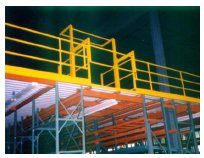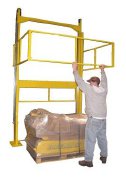Safety Gates Ensure Fail-Safe Fall Protection in Mezzanine AreasLaurie Hull, Sales Manager, Benko Products, Inc.
Mezzanine areas provide invaluable staging and storage space in warehouses and distribution centers, where space is at a premium. Often located 9 ft or more above the ground floor, mezzanines can also present a serious hazard to workers who must access freight delivered or stored at this level. OSHA standard 1910 Subpart D stipulates that employers must provide protection for personnel on walking-working surfaces – which include any surface higher than 4 ft above the ground floor. Many mezzanine areas are surrounded almost entirely by railing; however, in order for loads to be successfully delivered, this railing must contain a gap wide enough to allow freight onto the platform – and this section cannot contain a permanent guardrail.
Mezzanine safety gates play a pivotal role in industry, protecting personnel as well as maintaining OSHA compliance. While some may be tempted to use a simple chain rope strung across the railing gap to satisfy OSHA’s requirements, a rope serves more as a visual warning than an effective means of protection. Personnel may lose balance and fall over the chain or onto it – potentially breaking the barrier due to the weight applied, making it an insufficient solution. If a lift-out gate is used instead, the barrier is more stable but still exposes the worker to an unprotected ledge. An additional concern with both these solutions is that, to avoid the hassle of removing and replacing the rope or gate each time a load is delivered, an operator may purposefully leave the gap unguarded, presenting a critical risk.
A Better Approach
A mezzanine swing gate installed within the railing gap provides far better personnel protection. The most operator-friendly and safe design opens only 90 deg in one direction – toward the operator, rather than off the ledge – and features a self-closing design. However, this arrangement still requires employees to approach the very ledge of the mezzanine to open the gate, placing them at risk. In addition, if the last person who accessed the mezzanine mistakenly left the door unlatched, the next worker could be exposed to a hazardous situation.

A pivot-mount mezzanine gate functions via manual, counterweighted pivot operation and provides fail-safe protection by eliminating the potential risk of an open gate. This gate mounts directly beneath the mezzanine platform and replaces a single door with two cage-like enclosures that pivot on a central hinge, with a fixed framework on each side of the pivot mount. When the enclosure nearest to the edge of the mezzanine is lifted to allow load delivery to the platform, the second enclosure rests on the mezzanine itself – effectively blocking personnel from accessing the load, as well as the fall hazard. To access the load, the operator lifts the second enclosure, and the gate pivots so that the initial enclosure rests on the mezzanine floor. The operator can then step beneath both enclosures to access the load safely, without exposure to the mezzanine ledge.
This gate provides a significant advantage over alternative methods in that operators cannot bypass it and cannot be exposed to the mezzanine ledge, making it ideal for satisfying OSHA and insurance requirements. In addition, it’s more operator-friendly to use, since operators open the gate independently of handling the load. These gates are often painted “safety” yellow and may feature a durable, all-welded design that makes them ideal for withstanding harsh industrial and chemical environments.
The pivot-mount mezzanine gate provides superb personnel protection, but it may not be suited for every mezzanine area. As it consists of two enclosures, it consumes several square feet of mezzanine floor space. At times, space is at such a premium in these areas that the required square footage cannot be spared – either due to other equipment located within the area or stored goods that consume a majority of the available space. Plus, a pivot-mount gate only allows access to the front of the load; side access, which is required for some loads, is not possible with this style.
One Size Doesn't Fit All

A Clear-Aisle model mezzanine gate provides a low-profile design ideal for mezzanine areas with space constraints. This gate consists of two posts only 10 in. in depth mounted on the mezzanine ledge, with a “corral” between them consisting of three sides that is around 60 in. in depth. On the drop side by the ledge is a sliding gate that begins in the raised position to facilitate load delivery. When the sliding gate is up, the corral rests on the platform, thus protecting personnel from the fall hazard. Once the load is delivered, this framework is manually raised over the operator’s head, which thereby closes the sliding gate – thus blocking access to the mezzanine ledge. The overhead design allows the operator access to the load and work area on three sides and reduces the risk of obstructing nearby equipment or storage items.
While each mezzanine area can likely employ at least one of the above mezzanine safety gate styles, the gates often must be customized to meet specific application parameters. In many cases, this customization will cost only slightly more than standard models but provide an incalculably better solution. A pivot-mount gate may be designed so that the raised enclosure reaches a lower-than-standard height, fabricated to work around low-hanging ceiling beams or sprinkler heads. The framework of the gate itself may also be extended to accommodate larger loads or higher product stacks, as well as to work around any tanks or machinery installed in the mezzanine area. This allows simple delivery of many material loads – including material that may be used on-site to fill these tanks or other machinery on the mezzanine – while ensuring operator fall protection.
Gate construction may additionally be customized to withstand challenging application environments. For instance, a gate with a powder-coat finish provides an ideal solution for areas prone to corrosion, while stainless steel gates deliver an ideal sanitary solution for food and beverage areas. The combination of customization options, durable design, and fail-safe operation make these safety gates an ideal fall protection solution for the widest range of mezzanine areas.





